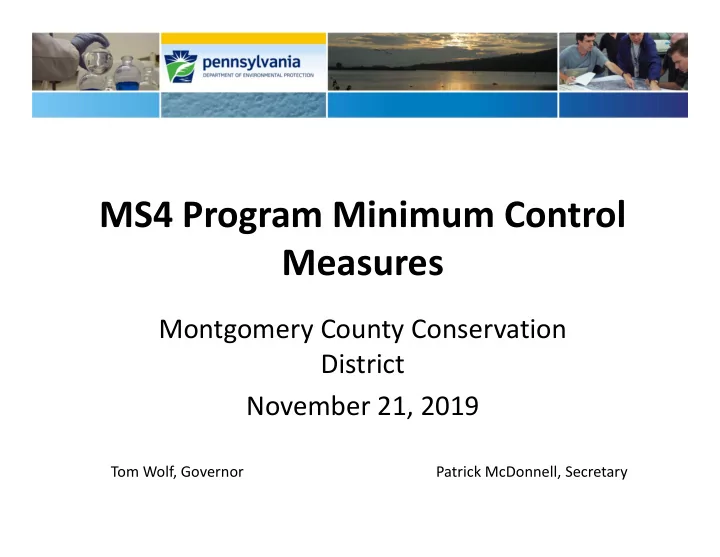

MS4 Program Minimum Control Measures Montgomery County Conservation District November 21, 2019 Tom Wolf, Governor Patrick McDonnell, Secretary
What is MS4? Municipal Separate Storm Sewer System
Why is MS4 Important?
Minimum Control Measures • Both the MS4 general permit (PAG‐13) and the MS4 individual permit require the development, implementation and enforcement of a stormwater management program (SWMP). There are six Minimum Control Measures (MCMs) that comprise the SWMP. Each MCM has its own set of best management practices (BMPs).
The Basic MS4 Program Can you list the six Minimum Control Measures?
Minimum Control Measures #1 Public Education and Outreach Program (PEOP) #2 Public Involvement and Participation Program (PIPP) #3 Illicit Discharge Detection & Elimination (IDD&E) #4 Construction Site Stormwater Run‐off #5 Post Construction Stormwater Management #6 Pollution Prevention/Good Housekeeping
Minimum Control Measures • Today we are going to focus on: MCM #4: Construction Site Stormwater Runoff Control MCM #5: Post‐Construction Stormwater Management (PCSM)
MCM #4 Construction Site Stormwater Runoff Control • MCM #4: Construction Site Stormwater Runoff Control. (25 Pa. Code § 92a.32(a) and 40 CFR § 122.34(b)(4))
MCM #4 Construction Site Stormwater Runoff Control • BMP #1: The permittee may not issue a building or other permit or final approval to those proposing or conducting earth disturbance activities requiring an NPDES permit unless the party proposing the earth disturbance has valid NPDES Permit coverage (i.e., not expired) under 25 Pa. Code Chapter 102. MCM #4 Construction Site St
MCM #4 Construction Site Stormwater Runoff Control • BMP #2: A municipality or county which issues building or other permits shall notify DEP or the applicable county conservation district (CCD) within 5 days of the receipt of an application for a permit involving an earth disturbance activity consisting of one acre or more, in accordance with 25 Pa. Code §102.42.
MCM #4 Construction Site Stormwater Runoff Control • BMP #3: Permittees must enact, implement and enforce an ordinance or SOP (non‐ municipal permittees) to require the implementation and maintenance of E&S control BMPs, including sanctions for non‐ compliance, as applicable.
Good Vs. Bad
Good Vs. Bad: Local Example Pictures taken by MCCD
Post‐Construction Stormwater Management (PCSM) • MCM #5: Post‐Construction Stormwater Management (PCSM) in New Development and Redevelopment. (25 Pa. Code § 92a.32(a) and 40 CFR § 122.34(b)(5))
Post‐Construction Stormwater Management (PCSM) • BMP #1: MS4 permittees must enact, implement and enforce an ordinance or SOP to require post‐construction stormwater management from new development and redevelopment projects, including sanctions for non‐compliance.
Post‐Construction Stormwater Management (PCSM) • BMP # 2: Permittees must develop and implement measures to encourage and expand the use of Low Impact Development (LID) in new development and redevelopment. Measures should also be included to encourage retrofitting LID into existing development.
Post‐Construction Stormwater Management (PCSM) • BMP #3: Ensure adequate O&M of all PCSM BMPs that have been installed at development or redevelopment projects that disturb greater than or equal to one acre, including projects less than one acre that are part of a larger common plan of development or sale.
Post‐Construction Stormwater Management (PCSM) • BMP #3: O&M Program Requirements: – Develop and maintain an inventory of PCSM BMPs. Track the following information in the inventory: • All PCSM BMPs that were installed to meet requirements in NPDES Permits for Stormwater Discharges Associated with Construction Activities approved since March 10, 2003.
Post‐Construction Stormwater Management (PCSM) • BMP #3: O&M Program Requirements (con’t.): • The exact location of the PCSM BMP (e.g., latitude and longitude, with street address). • Information (e.g., name, address, phone number(s)) for BMP owners and entities responsible for BMP O&M, if different from BMP owners. • The type of BMP and the year it was installed.
Post‐Construction Stormwater Management (PCSM) • BMP #3: O&M Program Requirements (con’t.): • Maintenance required for the BMP type according to the Pennsylvania Stormwater BMP Manual or other manuals and resources. • The actual inspection/maintenance activities conducted for each BMP. • An assessment by the permittee if proper O&M has occurred during the year and if not, what actions the permittee has taken, or shall take, to address compliance with O&M requirements.
Qualifying Local Programs (QLP) • Option to rely on a QLP – Usually will be with the county conservation districts – Considerations: • Does the municipality have an MOU with the QLP? • Does the QLP know the municipality is relying on them for MCMs 4 & 5? • Has the QLP agreed to take on that responsibility for the municipality?
Enforcement of Municipal Ordinances • The MS4 permits require the municipalities ENACT , IMPLEMENT , and ENFORCE their stormwater ordinances. • Ultimately it is the responsibility of the municipality to ensure compliance with its ordinances. • Municipal employees should be trained on: – Requirements of the municipal ordinances – How to identify E&S and PCSM violations. – What steps should be taken to rectify violations. – Enforcement options available to the municipality.
Why is a Stormwater Management Plan (SWMP) important?
Why is a Stormwater Management Plan (SWMP) important?
Why is a Stormwater Management Plan (SWMP) important?
Conclusion • The ultimate goal of the MS4 program is to turn our red streams blue. Once this is achieved, PRP and TMDL plans will no longer be needed. • At times, this goal may seem overwhelming and unattainable; however, the Brandywine Red Clay Alliance’s Red Streams Blue project in Chester County has documented increased water quality in some of their streams after implementing a variety of projects. (http://www.brandywineredclay.org/watershed‐ conservation/red‐streams‐blue/)
Conclusion (Cont.) • The key to success will be to form partnerships and working with your neighbors in implementing cost‐effective, high impact projects that will increase water quality, decrease flooding impacts, and increase the quality of life of your residents. County Government Businesses Residents Local Government Federal Government State Government Watershed Groups
Krista Brown – kristbrown@pa.gov Beth Mahoney – emahoney@pa.gov
Recommend
More recommend